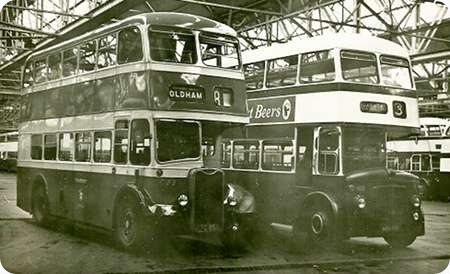
Oldham Corporation
1957
Leyland Titan PD2/20
Crossley H33/28R
This picture shows Ashton-under-Lyne Corporation Transport XTC 855 and Oldham Corporation Passenger Transport NBU 508 in Oldham’s Wallshaw Street Depot.
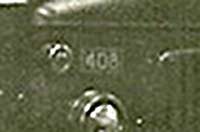
The photograph shows the cast fleet number plate that was a feature of the Oldham fleet at that time.
In this view 408s Coat of Arms is on the lower deck panel, until, like Ashton, they were moved to the front upper deck panels. This was to save the costs of replacement when damage occurred due to accidents.
The Service 3 was Middleton to Rushcroft.
408 was renumbered as 5308 in the SELNEC fleet in November 1969.
The picture shows the vast expanse of the roof of Wallshaw Street depot. The Garage roof having only 3 stanchions, supporting girders with spans of over 200ft.
Ashton XTC 855 was one of the Guy Arab IVs with Bond H32/28R bodywork delivered as No. 40 in 1956. Here it has Fleet No. 68 which it received in 1964. It was renumbered 5468 at the formation of SELNEC in November 1969.
It can be seen that the Corporation crest and lettering is in the normal position before being moved to the upper deck front panel (as shown in the photograph of No. 19 in Part One – Ashton under Lyne article by Phil Blinkhorn and Roger Cox).
It is in Oldham Garage, showing Service 8 which was the joint Oldham, Ashton, & SHMD service between Oldham and Stalybridge via Hurst Cross.
Photograph and Copy contributed by Stephen Howarth
12/09/13 – 16:30
Oldham 408 was numerically the first of five Leyland PD2/20 with Crossley bodies built to Park Royal design, after the takeover by the ACV group. Similar bodies were supplied to Ashton-Under-Lyne and Stockport Corporations at this time Crossley ceased body building soon after, although not before they had built the prototype Bridgemaster, which had many similarities to this body design. The Manchester independent A. Mayne and Son had three AEC Regent V with Park Royal bodywork to the same basic design (although in 30ft length.)
These bodies proved inferior to their contemporaries of other makes, and after takeover by Selnec PTE, 409 was overhauled and lasted in service until 1973, the rest of the batch were withdrawn in 1970.
Ashton-Under-Lyne Corporation was a Leyland User, and had only the one batch of Guy Arab IV’s. These were unusual in having exposed radiators and 5LW engines, as well as the relatively rare body make. I enjoyed several rides on these interesting buses from Ashton to Mossley, this route being their usual home.
I wonder why an Ashton bus was inside Oldham’s depot? At first I wondered if it was one of the many buses hired from other operators as a result of the disastrous visit by Ministry of transport inspectors in October 1965. However David Wayman’s book on Oldham buses states that there were no Ashton buses involved. Perhaps it had broken down in Oldham.
Don McKeown
13/09/13 – 06:30
An interesting photo of a neighbouring municipality’s vehicle interloping into the home fleet’s garage. I would venture this was a relatively rare occurrence in its day unless someone can enlighten us. The photo has made me realise what an attractive design the Bond bodies were in a fairly understated way. The Guy radiator looks a bit old fashioned and puts about 10 years on the body design though. The Birmingham tin front would have made them into really stunning buses. Bolton of course had similar bodies on exposed radiator Leyland PD2’s but somehow the Leyland radiator seemed to age much better and still looked good right up to the end of Titan production.
Philip Halstead
13/09/13 – 08:30
A number of points regarding Don’s comment. The Stockport PD2s with Crossley bodies to the same design didn’t have the same problems as the Oldham batch and some were sent to Oldham after SELNEC took over. As I’m away from home at present I can’t confirm actual vehicles used and the dates but the Stockport vehicles outlasted the Oldham and Ashton batches.
The Ashton Guys were specifically bought for the Mossley route – see my article on SELNEC Part One. They appeared on the 7 and 8 from time to time, both being regular Guy turns, more frequently operated with rebodied austerity Guys sporting 7 foot 6 in versions of the Crossley body shown in the picture.
What the bus is doing in the depot is a matter of conjecture. It certainly wasn’t a 1965 swap vehicle. A breakdown is possible but as there was always one of the batch spare and it may have been filling in for a broken down Oldham vehicle which came to grief in Ashton’s territory and would have been taken to Mossley Rd. Most of the joint services in the Manchester conurbation had vehicle swap arrangements should a vehicle come to grief in the territory of another operator.
Phil Blinkhorn
13/09/13 – 08:30
I know exactly what the Ashton Guy was doing in the Oldham garage and I even have the negative of this photo (although I didn’t take it). I’ve had to look very carefully as it is quite likely that very similar photographs were also taken.
Ashton 68 was on a tour organised by the Buckley Wells Bus Enthusiasts Society. It operated on 9th July 1967 and visited several locations in north Lancashire. Thanks to Stan Fitton, who organised the tour, I have photographs of the Ashton Guy next to Todmorden PD2s, a BCN Guy and an Accrington Wulfrunian. I hope in time to put these in a gallery recounting the history of the Society as I think many will find it an interesting story.
Although both these vehicles were allocated SELNEC fleet numbers neither carried them and in fact the Oldham PD2 had been withdrawn some time before SELNEC was formed.
David Beilby
13/09/13 – 16:30
I wonder why the blind was set for route number 8? Has David thwarted a ruse set 46 years ago to confuse future enthusiasts and historians? The date was my 20th birthday and I spent the day riding buses – far away from Oldham however.
They were two shades of green, exclusively single deck and carried a coat of arms containing the letters SPQR and a crown. I have in mind an article covering my wanderings on the city and country buses I used around Rome but am having problems finding relevant photos and accurate references to exact types.
Phil Blinkhorn
14/09/13 – 06:24
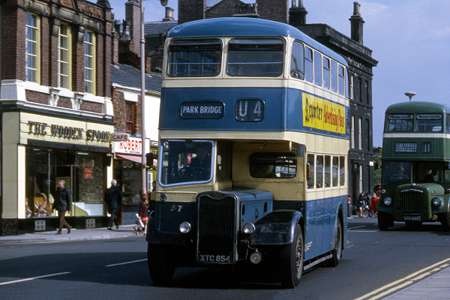
To quote Margaret Wolfe Hungerford, “Beauty is in the eye of the Beholder”. I consider the elegant and timeless Guy radiator on the Ashton Arab IVs to be much superior in appearance to the bulbous Birmingham style tin front. The best version of the Birmingham front was that fitted to the Dennis Lance K4 which had vertical chrome strips instead of the crude sausage shaped slots. Did these Ashton Arabs really have the 5LW engine? Hitherto, I understood the power plant to be the 6LW. Gardners were always cool runners, an effective oil cooler being an important feature of the engine design. The handsome Bond bodywork exhibits several similarities with contemporary five bay East Lancashire products. Perhaps Bond used the East Lancs frame. Then again, the Harkness bodies of the period had much the same appearance, and these used MetSec frames.
Roger Cox
14/09/13 – 16:19
Roger, as you are aware, I’m away at present but my memory and the references I can find on the Net all point to the 5LW engine. Bond used various frames inc Burlingham but I’ve no knowledge of any use of East Lancs frames and I’d doubt that the Blackburn concern would have supplied frames given just about every batch built by them in the 1950s and 1960s was unique, though I take your point about resemblance, especially the frontal appearance.
The Park Bridge service was an oddity. It followed the Oldham Rd to almost the boundary with Hathershaw then turned right down a winding road to Park Bridge, a hamlet established in the 18th century around an iron works. Its timings on weekdays were based around rush hours and a late evening service. Saturday saw an enhanced daytime service for shoppers but, until the closure of the Oldham to Guide Bridge and Stockport rail services in the Beeching era, the halt at Park Bridge provided a more frequent service though Oldham Rd station at Ashton was a good ten minutes walk from the market and shops, the final 200 yards back to the station being up a quite sharp gradient. The hamlet is now a heritage site with beautifully restored houses in a rural setting.
Phil Blinkhorn
15/09/13 – 07:25
Phil, your knowledge of the operators in the Manchester locality is rewardingly comprehensive, and, as you indicated in the Ashton article, these Guys must have been purchased for a specific reason. Nonetheless, it does seem extraordinary that Ashton should specify the 7 litre, 94 bhp 5LW engine to meet a situation that distressed a 9.8 litre, 125 bhp Leyland. The Gardner would assuredly climb a proverbial brick wall without overheating, but progress must have been decidedly sedate. On the subject of the body frames used by Bond, a contributor to the following website, named T W Moore (surely the well known bus photographer) suggests that Bond was an associated company of East Lancs (see the last post on the page):- //cwk205.freeforums.org/
Do you think that this was the case?
Roger Cox
15/09/13 – 09:36
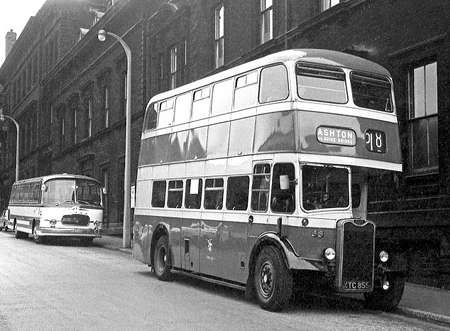
The attached photo shows the Ashton Guy at the start of this tour (and all the other Buckley Wells Bus Enthusiasts tours), Manchester Victoria station. 68 has as a backdrop the long-demolished buildings on Hunt’s Bank. The coach behind is unusual as it is a Setra from the Somme Département in France, as shown by the registration which ends with the number 80. Continental coaches were a rare sight in those days.
The blinds were set to all sorts of displays during the tour (it was an opportunity to practice this much-desired but usually not permitted activity). At Ashton it showed 159, certainly not an Ashton route, and a lot of time it showed the perennial favourite but incorrect Ashton display, “10 Downing Street”, which unfortunately came out as Downing St 10. Downing Street was a short working on the 5 to Droylsden via Littlemoss.
David Beilby
15/09/13 – 14:02
On the face of it the use of the 5LW looks odd but there may have been a very logical reason – at least in the minds of the members of the Transport Committee and the General Manager. The order was placed in the period in the 1950s when diesel prices and wages had escalated rapidly putting up costs against a background of increased availability of cars, an increase in home entertainment with a widening of TV output and a resistance against increased fares all of which produced a marked decline in passenger numbers.
Small and reduced output engines were not a rare phenomenon in the area and whilst the route to Mossley may have seemed to demand a large engine, a slow plodder which completed the journey, on what was a fairly relaxed schedule, was preferable to an enforced cooling stop or even a breakdown, which had become a regular and expensive enough occurrence. No other route in the system had such demands and the 5LW would have had a more racehorse like performance on the other routes to which Ashton’s Guys were allocated and to which the vehicles would eventually be tasked. I rode on both the Leylands and the Guys and whilst I was under ten at the time the Guys took over, I have memories of their stately progress compared to the rather raucous progress of the Leylands, which included much gear changing and stuttering starts from some of the bus stops on the steeper parts of the route, not to mention the overheating.
With regard to Bond, the posting linking the company to East Lancs contains a major nonsense in so far as it places the latter in Bridlington, not once but twice – hardly a typo. Apart from its own bodies Bond did finish bodies for other manufacturers and may well have taken the strain for East Lancs with the Coventry job but, as far as I have understood the rather obscure history of the company, it was totally independent of any other bus body builder, its demise in Wythenshawe coming about after protracted labour disputes between craft unions.
Phil Blinkhorn
15/09/13 – 16:50
Roger’s information with respect to the suggestion that the S.H. Bond concern was an associate of East Lancs. would go a long way towards explaining why the remainder of a batch of nine pre-war Bristol saloons of Rotherham Corporation, of which I think four had been rebodied by East Lancs. at Bridlington when the decision was taken to wind up the seaside operation in 1952, ended up being taken to Bond at Wythenshawe for the work to be done.
Dave Careless
15/09/13 – 16:51
Ashton’s Guy Arab IVs had 6LW engines. I get this information from a very detailed fleet list published by Ashton themselves about 1968 when the buses were part of the current fleet. As (I believe) the only Ashton buses ever fitted with a 6LW it is most unlikely they would have got that wrong. The fleet list shows withdrawn vehicles and the utility Guys are shown correctly with a 5LW engine.
Bond bodies were built on Metal Sections frames and were as good as anybody else’s. The closest connection they had to any other coach builder was Brush as the head of their bus operation had come from Brush when they moved out of the business.
One of these Guys was earmarked for preservation in early SELNEC days but a significant chassis defect meant that project was stillborn. It’s a shame as one of these would have been a fine testimony to a local coachbuilder, the sole representative being a contemporary Ashton trolleybus.
David Beilby
15/09/13 – 18:05
Phil, East Lancs did have a subsidiary business at Bridlington as the following web page confirms:- www.ebay.com/itm/
I do, however, agree with your assessment of the situation in that any connection between Bond and East Lancs occurred purely in the course of business; there was no inter company control. I am grateful to David for endorsing my belief that these Ashton Guys had 6LW engines. The revelation that the Bond bodies were built on Metal Section frames also ties in with the visual and quality similarities to the fine Harkness products of that time.
Roger Cox
15/09/13 – 19:19
Dave, I’m a little surprised that either Coventry or Rotherham accepted tenders from the Bridlington operation of East Lancs as I always understood this arm of the operation was to be wound down from the end of 1951, thus my thought that the reference to Bridlington in the link posted by Roger was in error. If the operation was still functioning in 1952, as seems to be the case, then it’s demise must have been delayed then brought on in very short order for vehicles to be moved to Bond, implying a hasty decision and that the Blackburn operation was operating at capacity.
Again, the movement to Bond doesn’t imply any legal connection or association. As mentioned before, Bond completed orders for a number of body builders, including three of the 1953 Royal Tiger half decker airport coaches for Manchester for which Burlingham supplied the frames, the Blackpool concern completing the other three itself.
David, as I mentioned previously, I’m away from home at the moment so can’t access my own records. If 6LW engines were fitted, they would certainly have been the only ones in the fleet and from a power point of view the bigger engine, as Roger points out, would be more logical though the references I can find say 5LW. The fleet list to which you refer has long been on my “must have” list but seems to be as rare as hens’ teeth.
As a rider to the above, the Commercial Motors’ archive which often can clear up seemingly contentious issues with contemporary news items is silent on both the demise of the Bridlington operation and the Ashton order for the Arab IVs.
Phil Blinkhorn
16/09/13 – 06:28
Bond were initially active in rebuilding before they turned their hand to building new bodies. Ribble was a big customer and most memorable were the early SLT trolleybuses that were given a new lease of life at Wythenshawe.
Significantly it appears from the fleet list elsewhere on this site that the Rotherham Bristols that went to Bond were also lengthened to (almost) the recent 30-foot limit, whereas the others were rebodied and remained the original length.
David Beilby
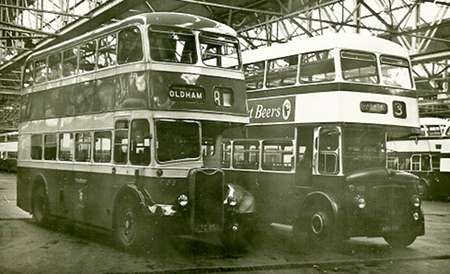 Vehicle reminder shot for this posting
Vehicle reminder shot for this posting
17/09/13 – 05:06
Phil, the story of East Lancashire Coachbuilders (Bridlington) Ltd., and sister company, Yorkshire Equipment Company, is a most interesting one. Apparently the latter built school furniture, desks and cupboards etc., and even constructed a furniture van body on an old Rotherham Bristol JO5G chassis with which to deliver the items to schools around the country.
Unfortunately, as orders for bus bodies and school desks inevitably dwindled, and commitment from owners wavered, the search for a buyer was unsuccessful, and both companies went into voluntary liquidation in mid-1952.
Dave Careless
19/11/13 – 18:04
In the comment above you make reference to Yorkshire Equipment being a subsidiary of East Lancs and being a school furniture maker. I had my own website back in Gocities days and had a page for makers. In doing research for Mann Egerton of Norwich, I found a US site that had school desks made by them. At one time they also made radios! Varied markets for many!
John Turnbull
Leave a Reply